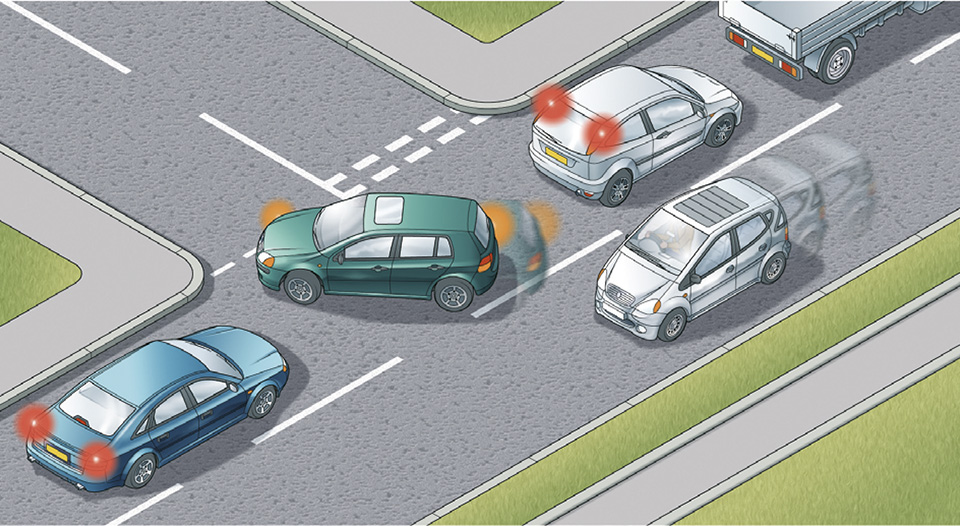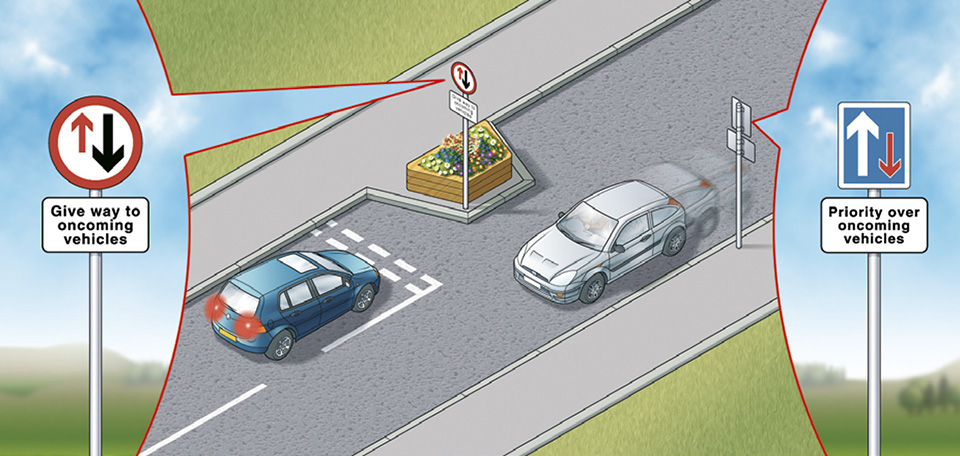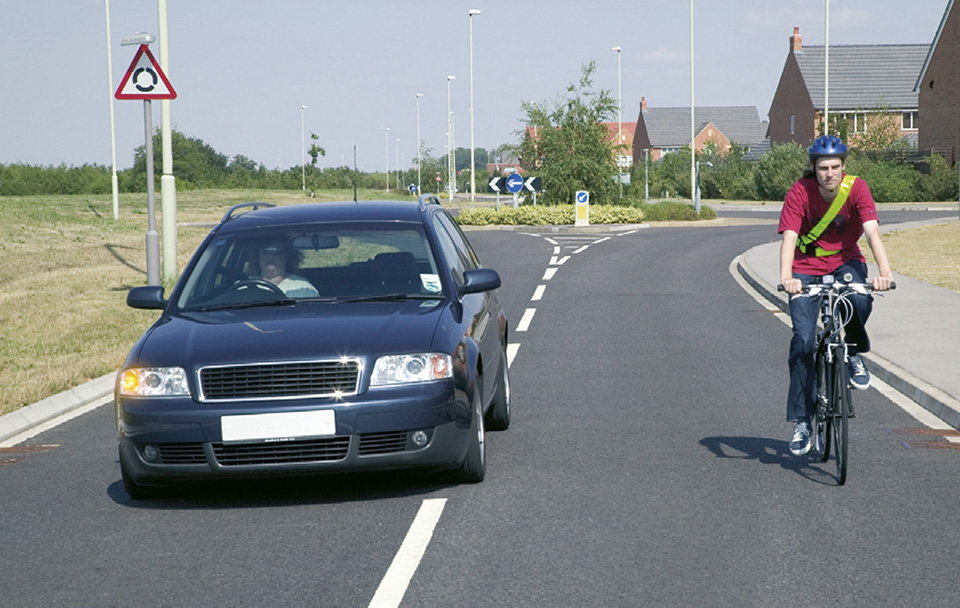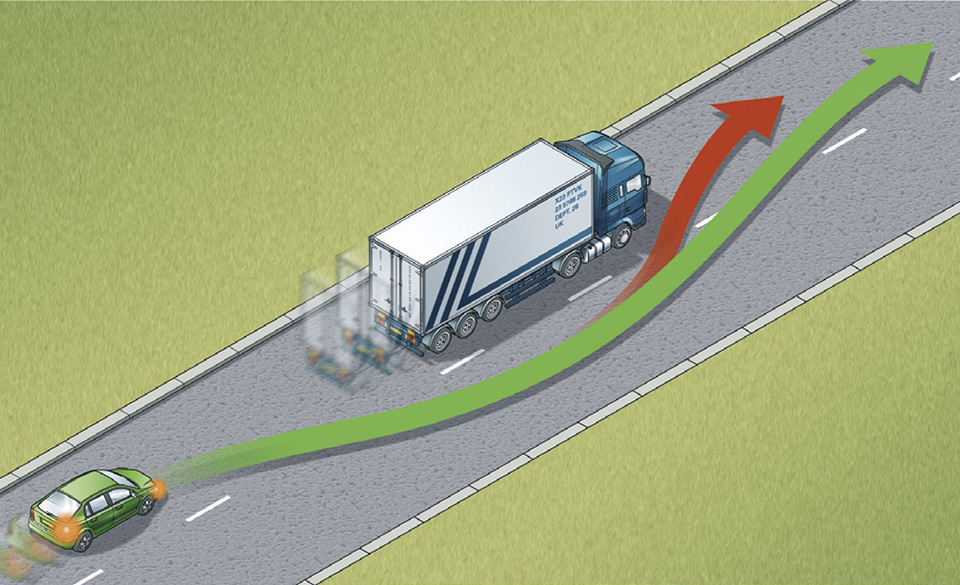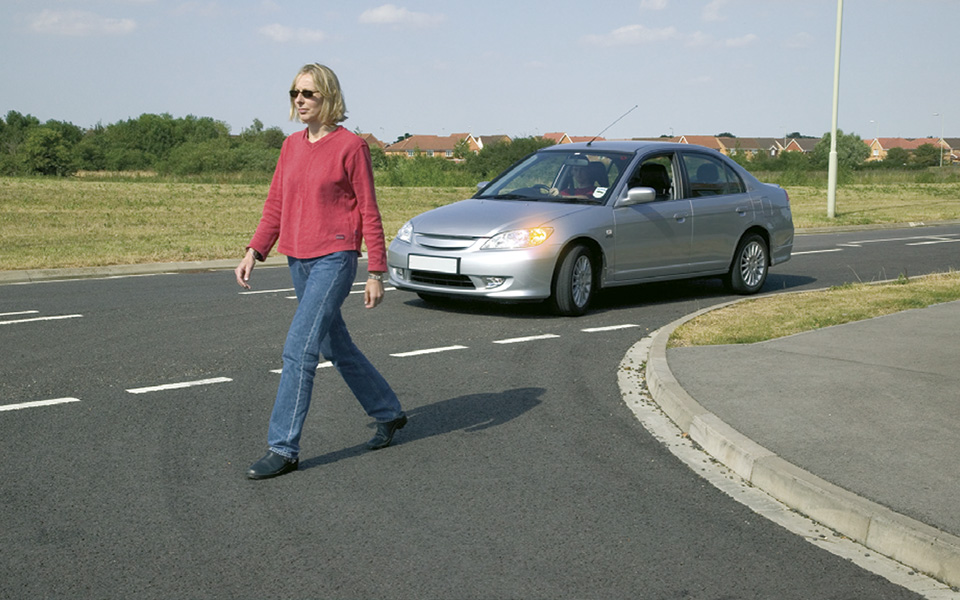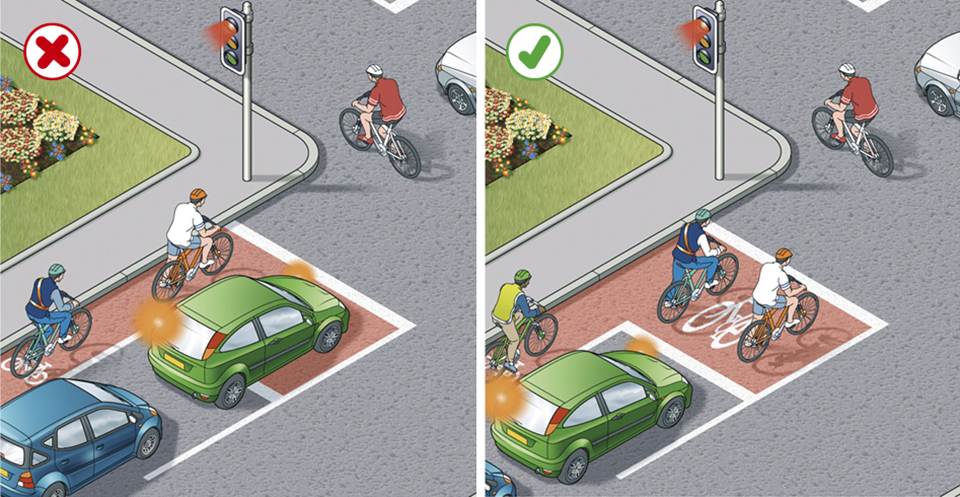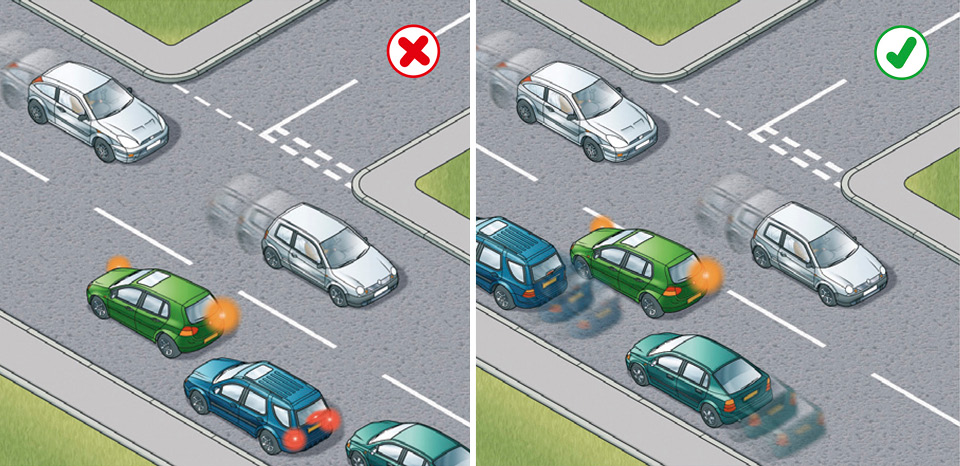- Drivers
- Motorcyclists
- Pedestrians
- Cyclists
- Children
- Horse riders
- Users of powered wheelchairs and mobility scooters
The Highway Code includes hundreds of rules, many of which are legal requirements. Violating these rules is a criminal offence which may lead to a fine, penalty points, disqualification from driving or being sent to prison in the most serious cases.
As a learner driver, knowledge and understanding of the Highway Code is essential. The questions that make up the driving theory test are derived from the Code so it is vital you revisit it regularly during your learning. We have set up this resource to aid your learning. You may browse the Highway Code rules below or use the search facility to find specific rules pertaining to a particular topic. For example, if you’re looking for information about “box junctions”, type in this term in the search box and hit enter. The rule containing information about this topic will appear (Rule 174). You may also save certain rules that you want to revisit at a later stage. By signing up for an account, you can access these saved rules in your dashboard.
If it has been a while since you took your test, you may not have looked at The Highway Code for a number of years. Just as driving or riding skills evolve and develop with time and experience, the rules and advice given in the Highway Code also change and evolve over time, for any number of reasons. Knowing and applying all the rules could help significantly reduce the number of road casualties. This is a responsibility we all share.
Ultimately, it is up to you to acquire and retain the knowledge contained in The Highway Code, regardless of whether you are a pedestrian or the user of any type of vehicle. It is your responsibility to ensure you keep up to date with the rules in The Highway Code – ignorance is no defence.
307 Highway Code Rules
Highway Code Rule 151
In slow-moving traffic. You should
- reduce the distance between you and the vehicle ahead to maintain traffic flow
- never get so close to the vehicle in front that you cannot stop safely
- leave enough space to be able to manoeuvre if the vehicle in front breaks down or an emergency vehicle needs to get past
- not change lanes to the left to overtake
- allow access into and from side roads, as blocking these will add to congestion
- be aware of cyclists and motorcyclists who may be passing on either side.
Highway Code Rule 152
Driving in built-up areas
Residential streets. You should drive slowly and carefully on streets where there are likely to be pedestrians, cyclists and parked cars. In some areas a 20 mph (32 km/h) maximum speed limit may be in force. Look out for
- vehicles emerging from junctions or driveways
- vehicles moving off
- car doors opening
- pedestrians
- children running out from between parked cars
- cyclists and motorcyclists.
Highway Code Rule 153
Traffic-calming measures. On some roads there are features such as road humps, chicanes and narrowings which are intended to slow you down. When you approach these features reduce your speed. Allow cyclists and motorcyclists room to pass through them. Maintain a reduced speed along the whole of the stretch of road within the calming measures. Give way to oncoming road users if directed to do so by signs. You should not overtake other moving road users while in these areas.
Highway Code Rule 154
Country roads
Take extra care on country roads and reduce your speed at approaches to bends, which can be sharper than they appear, and at junctions and turnings, which may be partially hidden. Be prepared for pedestrians, horse riders, cyclists, slow-moving farm vehicles or mud on the road surface. Make sure you can stop within the distance you can see to be clear. You should also reduce your speed where country roads enter villages.
Highway Code Rule 155
Single-track roads. These are only wide enough for one vehicle. They may have special passing places. If you see a vehicle coming towards you, or the driver behind wants to overtake, pull into a passing place on your left, or wait opposite a passing place on your right. Give way to road users coming uphill whenever you can. If necessary, reverse until you reach a passing place to let the other vehicle pass. Slow down when passing pedestrians, cyclists and horse riders.
Highway Code Rule 156
Do not park in passing places.
Highway Code Rule 157
Certain motorised vehicles do not meet the construction and technical requirements for road vehicles and are generally not intended, not suitable and not legal for road, pavement, footpath, cycle path or bridleway use. These include most types of miniature motorcycles, also called mini motos, and motorised scooters, also called go peds, which are powered by electric or internal combustion engines. These types of vehicle MUST NOT be used on roads, pavements, footpaths or bridleways.
Laws
Highway Code Rule 158
Certain models of motorcycles, motor tricycles and quadricycles, also called quad bikes, are suitable only for off-road use and do not meet legal standards for use on roads. Vehicles that do not meet these standards MUST NOT be used on roads. They MUST NOT be used on pavements, footpaths, cycle paths or bridleways either. You MUST make sure that any motorcycle, motor tricycle, quadricycle or any other motor vehicle meets legal standards and is properly registered, taxed and insured before using it on the roads. Even when registered, taxed and insured for the road, vehicles MUST NOT be used on pavements.
Laws
Highway Code Rule 159
Before moving off you should
- use all mirrors to check the road is clear
- look round to check the blind spots (the areas you are unable to see in the mirrors)
- signal if necessary before moving out
- look round for a final check.
Move off only when it is safe to do so.
Highway Code Rule 160
Once moving you should
- keep to the left, unless road signs or markings indicate otherwise. The exceptions are when you want to overtake, turn right or pass parked vehicles or pedestrians in the road
- keep well to the left on right-hand bends. This will improve your view of the road and help avoid the risk of colliding with traffic approaching from the opposite direction
- drive or ride with both hands on the wheel or handlebars where possible. This will help you to remain in full control of the vehicle at all times. You may use driver assistance systems while you are driving. Make sure you use any system according to the manufacturer’s instructions.
- be aware of other road users, especially cycles and motorcycles who may be filtering through the traffic. These are more difficult to see than larger vehicles and their riders are particularly vulnerable. Give them plenty of room, especially if you are driving a long vehicle or towing a trailer. You should give way to cyclists when you are changing direction or lane – do not cut across them.
- select a lower gear before you reach a long downhill slope. This will help to control your speed
- when towing, remember the extra length will affect overtaking and manoeuvring. The extra weight will also affect the braking and acceleration.
Highway Code Rule 161
Mirrors. All mirrors should be used effectively throughout your journey. You should
- use your mirrors frequently so that you always know what is behind and to each side of you
- use them in good time before you signal or change direction or speed
- be aware that mirrors do not cover all areas and there will be blind spots. You will need to look round and check.
Remember: Mirrors – Signal – Manoeuvre
Highway Code Rule 162
Before overtaking you should make sure
- the road is sufficiently clear ahead
- road users are not beginning to overtake you
- there is a suitable gap in front of the road user you plan to overtake.
Highway Code Rule 163
Overtake only when it is safe and legal to do so. You should
- not get too close to the vehicle you intend to overtake
- use your mirrors, signal when it is safe to do so, take a quick sideways glance if necessary into the blind spot area and then start to move out
- not assume that you can simply follow a vehicle ahead which is overtaking; there may only be enough room for one vehicle
- move quickly past the vehicle you are overtaking, once you have started to overtake. Allow plenty of room. Move back to the left as soon as you can but do not cut in
- take extra care at night and in poor visibility when it is harder to judge speed and distance
- give way to oncoming vehicles before passing parked vehicles or other obstructions on your side of the road
- only overtake on the left if the vehicle in front is signalling to turn right, and there is room to do so
- stay in your lane if traffic is moving slowly in queues. If the queue on your right is moving more slowly than you are, you may pass on the left. Cyclists may pass slower moving or stationary traffic on their right or left and should proceed with caution as the driver may not be able to see you. Be careful about doing so, particularly on the approach to junctions, and especially when deciding whether it is safe to pass lorries or other large vehicles.
- give motorcyclists, cyclists and horse riders and horse drawn vehicles at least as much room as you would when overtaking a car (see Rules 211 to 215).
As a guide:
- leave at least 1.5 metres when overtaking cyclists at speeds of up to 30mph, and give them more space when overtaking at higher speeds
- pass horse riders and horse-drawn vehicles at speeds under 10 mph and allow at least 2 metres of space
- allow at least 2 metres of space and keep to a low speed when passing a pedestrian who is walking in the road (for example, where there is no pavement)
- take extra care and give more space when overtaking motorcyclists, cyclists, horse riders, horse drawn vehicles and pedestrians in bad weather (including high winds) and at night
- you should wait behind the motorcyclist, cyclist, horse rider, horse drawn vehicle or pedestrian and not overtake if it is unsafe or not possible to meet these clearances.
Remember: Mirrors – Signal – Manoeuvre
Highway Code Rule 164
Large vehicles. Overtaking these is more difficult. You should
- drop back. This will increase your ability to see ahead and should allow the driver of the large vehicle to see you in their mirrors. Getting too close to large vehicles, including agricultural vehicles such as a tractor with a trailer or other fixed equipment, will obscure your view of the road ahead and there may be another slow-moving vehicle in front
- make sure that you have enough room to complete your overtaking manoeuvre before committing yourself. It takes longer to pass a large vehicle. If in doubt do not overtake
- not assume you can follow a vehicle ahead which is overtaking a long vehicle. If a problem develops, they may abort overtaking and pull back in
Highway Code Rule 165
You MUST NOT overtake
- if you would have to cross or straddle double white lines with a solid line nearest to you (but see Rule 129)
- if you would have to enter an area designed to divide traffic, if it is surrounded by a solid white line
- the nearest vehicle to a pedestrian crossing, especially when it has stopped to let pedestrians cross
- if you would have to enter a lane reserved for buses, trams or cycles during its hours of operation
- after a ‘No Overtaking’ sign and until you pass a sign cancelling the restriction.
Laws
Highway Code Rule 166
DO NOT overtake if there is any doubt, or where you cannot see far enough ahead to be sure it is safe. For example, when you are approaching
- a corner or bend
- a hump bridge
- the brow of a hill.
Highway Code Rule 167
DO NOT overtake where you might come into conflict with other road users. For example
- approaching or at a road junction on either side of the road
- where the road narrows
- when approaching a school crossing patrol
- on the approach to crossing facilities
- where a vehicle ahead is slowing to stop for a pedestrian that is crossing from a pedestrian island (see Rule 165)
- between the kerb and a bus or tram when it is at a stop
- where traffic is queuing at junctions or road works
- when you would force another road user to swerve or slow down
- at a level crossing
- when a road user is indicating right, even if you believe the signal should have been cancelled. Do not take a risk; wait for the signal to be cancelled
- stay behind if you are following a cyclist approaching a roundabout or junction, and you intend to turn left. Do not cut across cyclists going ahead, including those using cycle lanes and cycle tracks (see Rule H3)
- stay behind if you are following a horse rider or horse drawn vehicle approaching a roundabout or junction, and you intend to turn left. Do not cut across a horse rider or horse drawn vehicle going ahead
- when a tram is standing at a kerbside tram stop and there is no clearly marked passing lane for other traffic.
Highway Code Rule 168
Being overtaken. If a driver is trying to overtake you, maintain a steady course and speed, slowing down if necessary to let the vehicle pass. Never obstruct drivers who wish to pass. Speeding up or driving unpredictably while someone is overtaking you is dangerous. Drop back to maintain a two-second gap if someone overtakes and pulls into the gap in front of you.
Highway Code Rule 169
Do not hold up a long queue of traffic, especially if you are driving a large or slow-moving vehicle. Check your mirrors frequently, and if necessary, pull in where it is safe and let traffic pass.
Highway Code Rule 170
Take extra care at junctions. You should
- watch out for cyclists, motorcyclists and pedestrians including powered wheelchairs/mobility scooter users as they are not always easy to see. Be aware that they may not have seen or heard you if you are approaching from behind
- give way to for pedestrians crossing or waiting to cross a road into which or from which you are turning. If they have started to cross they have priority, so give way (see Rule H2)
- remain behind cyclists, horse riders, horse drawn vehicles and motorcyclists at junctions even if they are waiting to turn and are positioned close to the kerb
- watch out for long vehicles which may be turning at a junction ahead; they may have to use the whole width of the road to make the turn (see Rule 221)
- watch out for horse riders who may take a different line on the road from that which you would expect
- not assume, when waiting at a junction, that a vehicle coming from the right and signalling left will actually turn. Wait and make sure
- look all around before emerging. Do not cross or join a road until there is a gap large enough for you to do so safely.
Highway Code Rule 171
You MUST stop behind the line at a junction with a ‘Stop’ sign and a solid white line across the road. Wait for a safe gap in the traffic before you move off.
Laws
Highway Code Rule 172
The approach to a junction may have a ‘Give Way’ sign or a triangle marked on the road. You MUST give way to traffic on the main road when emerging from a junction with broken white lines across the road.
Laws
Highway Code Rule 173
Dual carriageways. When crossing or turning right, first assess whether the central reservation is deep enough to protect the full length of your vehicle.
- If it is, then you should treat each half of the carriageway as a separate road. Wait in the central reservation until there is a safe gap in the traffic on the second half of the road.
- If the central reservation is too shallow for the length of your vehicle, wait until you can cross both carriageways in one go.
Highway Code Rule 174
Box junctions. These have criss-cross yellow lines painted on the road (see ‘Road markings‘). You MUST NOT enter the box until your exit road or lane is clear. However, you may enter the box and wait when you want to turn right, and are only stopped from doing so by oncoming traffic, or by other vehicles waiting to turn right. At signalled roundabouts you MUST NOT enter the box unless you can cross over it completely without stopping.
Law
Highway Code Rule 175
You MUST stop behind the white ‘Stop’ line across your side of the road unless the light is green. If the amber light appears you may go on only if you have already crossed the stop line or are so close to it that to stop might cause a collision.
Laws
Highway Code Rule 176
You MUST NOT move forward over the white line when the red light is showing. Only go forward when the traffic lights are green if there is room for you to clear the junction safely or you are taking up a position to turn right. If the traffic lights are not working, treat the situation as you would an unmarked junction and proceed with great care.
Laws
Highway Code Rule 177
Green filter arrow. This indicates a filter lane only. Do not enter that lane unless you want to go in the direction of the arrow. You may proceed in the direction of the green arrow when it, or the full green light shows. Give other traffic, especially cyclists, time and room to move into the correct lane.
Highway Code Rule 178
Advanced stop lines. Some signal-controlled junctions have advanced stop lines to allow cyclists to be positioned ahead of other traffic. Motorists, including motorcyclists, MUST stop at the first white line reached if the lights are amber or red and should avoid blocking the way or encroaching on the marked area at other times, e.g. if the junction ahead is blocked. If your vehicle has proceeded over the first white line at the time that the signal goes red, you should stop as soon as possible and MUST stop at the second white line. Allow cyclists, including any moving or waiting alongside you, enough time and space to move off when the green signal shows.
Drivers of large vehicles should stop sufficiently far behind the first white line so that they can see the whole area where cyclists may be waiting, allowing for any blind spot in front of the vehicle.
Laws
Highway Code Rule 179
Well before you turn right you should
- use your mirrors to make sure you know the position and movement of traffic behind you
- give a right-turn signal
- take up a position just left of the middle of the road or in the space marked for traffic turning right
- leave room for other vehicles to pass on the left, if possible.
Highway Code Rule 180
Wait until there is a safe gap between you and any oncoming vehicle. Watch out for cyclists, motorcyclists, pedestrians and other road users. Check your mirrors and blind spot again to make sure you are not being overtaken, then make the turn. Do not cut the corner. Take great care when turning into a main road; you will need to watch for traffic in both directions and wait for a safe gap.
Remember: Mirrors – Signal – Manoeuvre



